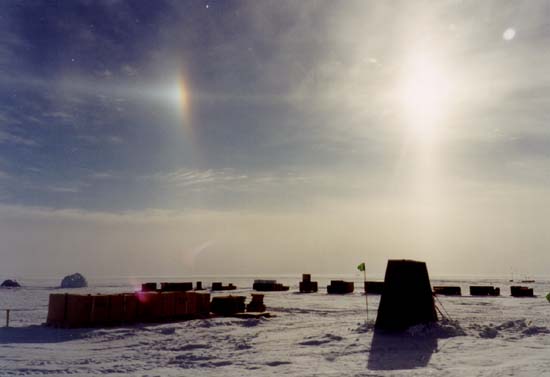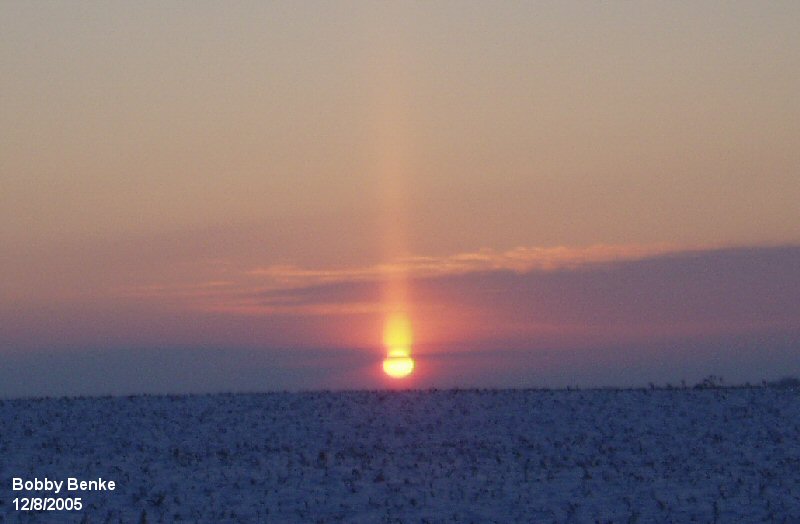 |
| Sun Halo on the Vernal Equinox 2021 Long Lake National Wildlife Refuge, photo by Lillian Crook |
Spring weather came to North Dakota early this year, the fifth driest winter here on record. The sky has been filled with migrating Canada Geese and some crazy fishermen have already had their boats on the nearby Missouri River, even though there is still ice on the banks.
My first birding excursion of the year took place earlier this week with my daughter, Chelsea. We spotted FOY (birder-speak for first of the year) American Kestrels and a few other birds, but the highlight of the day was a huge flock of Red-winged Blackbirds, east of Bismarck, close to a thousand on the ground in one small area of a stubble field. Hundreds of the birds would rise in the flight pattern called a murmuration, just a few feet above the ground, then fly over to the opposite edge of the flock, and land, and thus the constant churning, with the birds on the outside edge ever-changing. Chelsea shot video you can watch here. .)
In observation of the Vernal Equinox and our wedding anniversary, today found Jim and I birding the wetlands and lakes east of Bismarck, in the hopes of spotting the enormous flocks of Snow Geese reported overhead, and perhaps a Western Meadowlark or Sandhill Cranes. Along the way, we spied many early spring arrivals, brought in by strong south winds, and eleven Bald Eagles, on the ice hunting stray gulls and wounded geese. It is worrisome how dry the wetlands are -- the shorebirds are going to find slim pickings if we don't get a deluge soon.
At Long Lake National Wildlife Refuge -- Success! A couple thousand Snow Geese flew over, first in one flock, then scattering into smaller flocks. And then I noticed the sun halo, or what Jim called a "winter rainbow." Because the temperature was about 60 degrees, it was unexpected, but, of course, the temperature is much colder thousands of feet up in the atmosphere. Then the geese skirted across the sun halo and I managed to capture another photo in which one flock can be seen.
 |
| Snow Geese over Sun Halo, Vernal Equinox 2021 Long Lake National Wildlife Refuge, photo by Lillian Crook |
Halos can be seen around the sun and the moon and are called "22-degree halos" by scientists because the ring's radius is 22 degrees around the orb. These are caused by ice crystals in thin, high cirrus clouds. And here is perhaps the most enchanting piece, as described by Earth & Sky, my go-to website: Everyone sees their own particular halo, made by their own particular ice crystals, which are different from the ice crystals making the halo of the person standing next to you. I've seen a few really lovely moon halos, but today's sighting of the sun halo will be a memory I cherish (sadly, we saw no meadowlarks).
You can read more about this phenomena at Earth & Sky (which includes a lovely photo of a moon halo taken near Mandan, ND) and learn more about the equinox as well.
Halos are different from "sun dogs", as described on the weather.gov website and shown below:
The reason that Jim said, when I pointed the sun halo out to him, "winter rainbox" is that the poet Paul Southworth Bliss, whose biography we are writing, wrote a poem about these when he was living in North Dakota in the 1930s, another time of historic drought. The poem is published in Bliss's book, Cirrus from the West, published in 1935.
Winter Rainbox
by Paul Southworth Bliss
Out of the oakland,
Out of the pineland,
Near the time of sunset,
I came to the un-treed plains.
On the frost-struck air
There lay two segments
Of a mighty wheel,
Sunk to the sun-hub
In the glistening prairie.
The inner ring was rose,
The middle maize,
The outer
Power-puff green.
And the two segments
Were awesome arches
Between the snow-clad earth
And the blue zenith!
I have lived through war,
I have lived through floods,
And storms and droughts . . .
No matter;
I have seen at last
That miracle of miracles,
The winter rainbow.
December 28, 1934
Fargo, N. D.
The phenomenon of the sundogs is relatively common; but until today I had never seen them expanded into sections of a winter rainbow. This marvel of the plaines appeared at about 3:50 P.M., today, and continued for nearly fifteen minutes. I had emerged from the gloom of the oak and pine lands of Minnesota and burst onto the prairie in air that, due to the low temperatures (at least zero), glittered with billions of frost particles.


